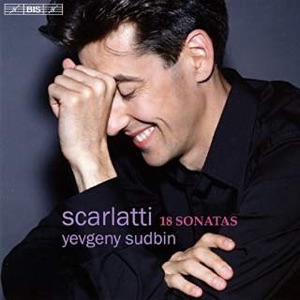Yevgeny Sudbin has waited 10 years before offering a second selection of Scarlatti sonatas. In his always intelligent booklet notes he refers to playing Scarlatti on the piano as akin to making “transcriptions” of the originals, so different is the modern instrument from those at Scarlatti’s disposal. Perhaps. It might be more accurate to say that Sudbin plays these pieces like transcriptions. A modern piano can do just about anything a harpsichord can do, some things more easily, others less so, but in the event Sudbin has chosen to exploit the resources of his instrument fully. The result is highly pianistic, often provocative, and quite different from his first Scarlatti recital, where brilliance and spontaneity ruled the day.
The brilliance certainly remains; the spontaneity less so. It’s surely no coincidence that the program opens with an outwardly “studied” piece–a splendidly clear account of one of Scarlatti’s few fugues, the Sonata in D minor K. 417, and that 10 of the included sonatas are rooted in minor keys. Sudbin’s approach works most convincingly, unsurprisingly, in the slower, intimate pieces that call for a long lyrical line: the sonatas K. 208, 213, 99, 32, and the marvelous K. 328 in F-sharp major, among others. There are moments where you might be forgiven for thinking that you were listening to a Chopin nocturne; the music acquires great poetry and timelessness.
On the other hand, the popular K. 141, with its manic repeated notes, fails in this rushed adaptation, with its blurred articulation and pounding left hand chords. Angela Hewitt, in her recent Scarlatti recital on piano for Hyperion, shows how it can (and should) be done, and it’s all the more curious since Sudbin manages the similar writing in K. 119 in D major with idiomatic flair. He takes great liberties with repeats in both the “A” and “B” sections of these works, altering dynamics, articulation, ornamentation–you name it. This can be enchanting, as in K. 159 in C major, where the imitation of horns coming from a distance on the first half repeat is simply magical.
At other moments, however, you might get the impression that Sudbin is trying just a bit too hard. In this he resembles his colleague, Mikhail Pletnev, whose Scarlatti recital for Virgin was similarly idiosyncratic, but also remarkably personal and affecting. Certainly Sudbin characterizes every note, and his willingness to explore some delightful but relatively lesser-known works (K. 125 and K. 373, in G major/minor for example) can only be applauded. If this sequel isn’t quite as enticing as Sudbin’s original, then, it is different: more reflective, perhaps more mature in some ways. In any case, no one can accuse him of serving up more of the same, and BIS’ engineering is uniformly outstanding. Recommended, then, especially for connoisseurs.
































